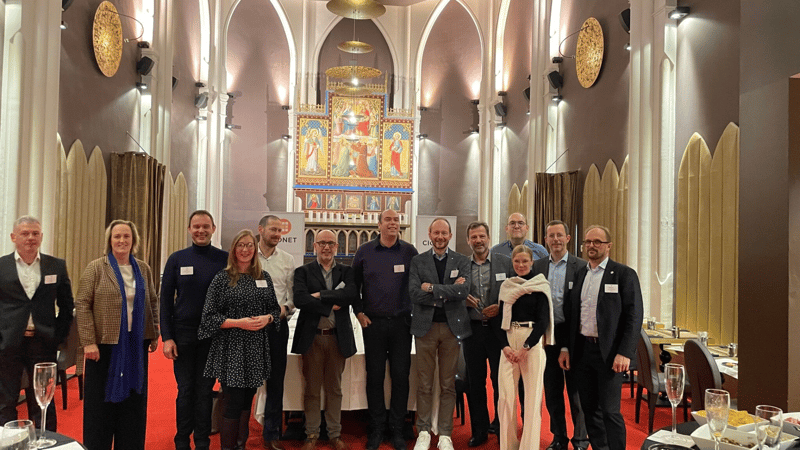
Blog article based on the discussions at the Roundtable set up by CIONET and SPLUNK on November 21, 2023, by Jaana Nyfjord and Kirsty Paine, both Field CTO at Splunk.
Autonomous, self-managing IT - is it real? CIONET and Splunk hosted a roundtable on this topic last week in Belgium, at the stunning venue of Martin’s Patershof in Mechelen - and the topic clearly drew attention. CIOs representing a variety of European industries and sectors joined a lively and interactive roundtable to uncover both the promise and boundaries of autonomous IT.
As defined by CIONET, the concept of an “Autonomous IT environment” envisions an IT setup where automated processes, artificial intelligence, machine learning, and data-driven insights work together to ensure high-quality services, minimise manual intervention, optimise performance, predict and prevent incidents, and make informed decisions based on real-time data.
The term “autonomous” signifies a level of self-governance, intelligence, and adaptability that goes beyond traditional IT management practices - not merely automation. Autonomous IT environments are aimed at enhancing efficiency, reducing downtime, improving security, and enabling IT teams to focus on higher-value tasks. In this interactive session, this group shared their journeys and uncovered both the possibilities and challenges surrounding autonomous IT.
So, fantasy or feasibility? This group concluded that it’s technically attainable and feasible, but that we are all still on a journey towards a goal that is not yet fully visible nor well-defined. Importantly, we are not alone. This is a reassuring statement to many, though autonomous IT echoes our familiar experience with the ever-changing technology landscape and the emergence of new technologies.
What are the drivers of autonomous IT? To no one’s surprise, the top of the list of motivating factors were cost, efficiency, speed and liberating time and human skills for innovation gains.
A number of challenges were naturally identified and explored during the evening. As mentioned, the shared belief is that autonomous IT is technically feasible, but it’s not the underlying technology that is the bottleneck to reaping the benefits of autonomy or self-managing IT. The challenges lie in the complexity and scale of our technology stacks, and importantly organisational stacks, horizontal and vertical, and the ability to align changing these stacks concurrently and continuously. It requires working up and down the stack, and end-to-end across multiple stacks. The group also agreed that an organisation’s operating model is critical to success, best leveraging where a service- or product-oriented model, or an approach to delivery has worked in creating changes. Those that already have or are migrating to the cloud, also added that the cloud enables change at scale by providing foundational infrastructure and removing silos.
Another outstanding example of a challenge was the lack of clear, precise goals and expected outcomes, which are critical for setting the direction for productive implementation of multi-stack change, both short and long-term. It seems that although the willingness to embrace the benefits of these technologies, the fact that it's a “black box” combined with many moving parts means that visibility is blurred. Consequently, feedback loops for systematic follow-up are broken, also impacting the possibility to gain learning, and insight and make consistently informed decisions. Many find it difficult to fully identify the value and thus define precisely the wanted position and measurable outcomes from self-managing IT. It was suggested that to improve visibility inside an organisation, dashboards shared across various stakeholder groups and decision-makers had been useful and filled blind spots.

In truly getting the benefits at the organisation level across all stacks, and ultimately boosting the customer experience and delivering on one’s customer promise, a participant shared their approach: “Don’t dazzle with tech, but align first on what we want to accomplish.”
An open question was raised at the end, is autonomous IT desirable? Voices were mixed. The development of AI is bringing a paradigm shift that is beyond much public understanding. For now, being able to protect systems and prove that they work as expected is on top of everyone’s mind. Until we have explainable and safe AI, we stay cautious about its application.
Everyone agreed that although guidelines are evolving we need to demonstrate that a system decision taken was right which requires inbuilt feedback.
The status of autonomous and self-managing IT differs between companies depending on a variety of factors, e.g. industry, size, culture and regulations. This tells me that we are in the Known Unknowns, as defined by Cynefin - a framework for leading in complexity and dealing with uncertainty through learning.
.png?width=800&height=450&name=BE20231121%20-%20Splunk%20Banner%20(1).png)
Conclusion
This open exchange between experts and industry leaders shows that we must keep focusing diligently on the Knowns to gain consistent learning and insight through each step into the Unknowns and ensure that feedback loops across the stacks are not broken. “Think big, start small” as another CIO stated.
The conversation covered multiple angles and parts of autonomy and concluded that automation is often conflated with autonomy. Moreover, there's no doubt that technology development is in the driver’s seat. So what is missing to move effectively? It calls for alignment across multiple stacks. Four requirements are needed to progress in this journey:
With these four factors firmly in place, autonomous IT is no longer just a fantasy.
CIONET extends its gratitude to Splunk, Jaana Nyfjord, Kirsty Paine, and Dirk De Meirsman, to the speakers Geert Goethals and Eric Mailleux, and finally to all participants for their insightful and enthusiastic discussion.
--
These Stories on CIONET Belgium
No Comments Yet
Let us know what you think